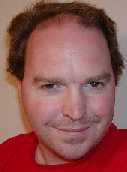Blake Bailey, the author of the Richard Yates A Tragic Honesty who inspired a drinking game here earlier in the year, has a new John Cheever biography coming out. The Boston Globe caught up with Bailey. Thanks to a $42,000 Guggenheim fellowship, Bailey says he plans to spend the next two years explaining how Cheever arrived at his tombstone. (Bailey has until December 2007 to deliver the manuscript.) Which suggests an equally arduous and equally moribund biography of another great writer. But Bailey says that he plans to approach Cheever’s life as “a redemptive fable.” Bailey has already talked to half of his 150 sources and read all 28 volumes of Cheever’s private journals.
Month / June 2005
McGraw Hill: When Will They Learn?
In 2003, Diane Ravitch’s The Language Police chronicled the often ridiculous lengths that school textbook publishers resort to not to offend anyone. For example, according to some of the mandates, a dinosaur can’t be mentioned because this implies the theory of evolution. Further, no stories or pictures of a mother cooking dinner are allowed because this reinforces a stereotype. (Unsurprisingly, many of these ideas, which involve preposterous gender-neutral rephrasings of questions and promoting abstinence over contraception, were whipped up by McGraw-Hill. One professor, Sean G. Massey, was so furious that he initiated a boycott.)
As if publishing approaches to school textbooks wasn’t absurd enough, McGraw-Hill is now hoping to target children in Canada with ads placed within their textbooks. The Toronto Star reports that McGraw-Hill has been “quietly trying to coax companies into buying advertising space in their texts.”
McGraw-Hill has a history of doing this. In 1999, a McGraw-Hill mathematics textbook featured an equation asking students to figure out how much money they needed to save to buy a pair of Nikes. The outcry resulted in AB 116, banning commercial images in public school textbooks in California.
Hopefully, the Canadians might take a cue from this.
House Kills Public Television Funding
A House subcommittee has voted to cut all federal funds for the Corporation of Public Broadcasting within two years. That’s $400 million a year, comparative chump change in the federal budget, to destroy a broadcasting conduit that offers educational and alternative programming to the public.
These creeps truly want the public to remain uneducated. Super Bowl, yes. Sesame Street and Frontline, no.
Fun with Face Analyzer
 According to Face Analyzer, the following “personality” can be determined from my face:
According to Face Analyzer, the following “personality” can be determined from my face:
Intelligence: 6.5 (Average Inteligence)
Risk: 4.2 (Low Risk)
Ambition: 6.2 (Average Ambition)
Gay Factor: 1.5 (Very Low Gay Factor)
Honor: 4.8 (Average Honor)
Politeness: 6.2 (Average Politeness)
Income: 6.4 ($30,000-$50,000)
Sociability: 5.1 (Average Sociability)
Promiscuity: 3.5 (Low Promiscuity)
My archetype, apparently, is Beta Academic.
Even more shocking, the celebrity face that I match up most with is Richard Gere. I’m not entirely certain about that. He has more hair than I do. But apparently I’m more polite than he is.
Because I’m suffering again from insomnia, I tried seeing if I could hack this system by submitting multiple images of my face in various poses (using the same lighting, the same red tee, the same stubble and the same white wall). When I stuck out my tongue, my income level dropped and my intelligence level dropped nearly a full point. Even stranger, my honor level went up when I took a photo of my face in crazy mode.
Nothing, however, fluctuated beyond a point. Sadly, my promiscuity score remained stable in all poses. I had hoped my gay factor would shoot up, but there was little I could do to get it beyond 1.6.
Whatever one thinks of the accuracy of this test, it does serve as a nice counterpart to Malcolm Gladwell’s “The Naked Face” — an essay from several years ago. The Face Analyzer has a 87% success rate determining race and gender. Unfortunately, there’s little on the Face Analzyer site that indicates how the personality attribute score is calculated. All we know is that the picture is sent to a facial recognition engine, which is purportedly the world’s most accurate software. Too bad they couldn’t name the software they’re using or the engineers and scientists who developed it.
[UPDATE: Tito runs some tests of his own. Apparently, the pre-jailed James Brown is a “white collar” type.]
Burgess’s 99
I’ve been on an Anthony Burgess kick lately. But what I didn’t realize was that back in 1984, Burgess offered a list of the Best 99 Modern Novels between 1939 and 1984, novelists who “have added something to our knowledge of the human condition.”
As can be expected, James Joyce and Flann O’Brien are there. But there are some quirky choices too, such as David Lodge’s How Far Can You Go?, J.G. Ballard’s The Unlimited Dream Company, John O’Hara’s wildly ambitious The Lockwood Concern and Erica Jong’s How to Save Your Own Life.
Beyond this list, there are some interesting revelations about Burgess in the article. For one, Burgess once had “the notion of writing a fiction of a dying man who sees the unfolded Times on his bed and deliriously traces all his past life as though it were the content of that newspaper – news items, editorials, crossword puzzle, everything.” The other thing, and it’s perhaps an invaluable piece of info for those impoverished souls who left BEA with copious swag, is that when Burgess wrote book reviews for the Yorkshire Post, the local post office had to hire additional staff to take in the book parcels. Further, since Burgess was paid a pittance, every two weeks, Burgess would pack two book-filled suitcases and sell all of his review copies at half price.